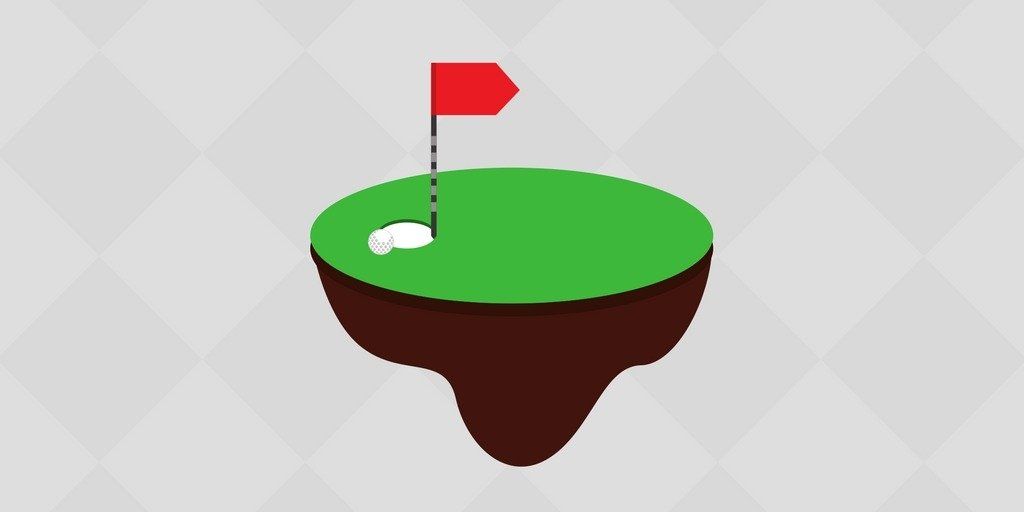
Double bogey is defined as scoring two over par on a hole, but that simple definition doesn't even come close to giving this term justice. No matter what level of golf you are playing, being able to avoid a double bogey is one of the main factors to your success.
Most players are under the assumption that birdies and pars are going to be the path to golf improvement. It makes sense because these are "fun" scores. The truth is that damage control is a more important skill for many players, and avoiding a double bogey or worse is going to help them break 80, 90, or 100.
Golf is a game of mistakes, and you have to take care of those mistakes in order to be successful. On some holes you are going to execute very well, and mark down that birdie or par, but more often than not your goal is really to be fighting for that bogey.
If you want to get rid of those double bogeys, read ahead. These are the key ideas you are going to have to master on the course.
Grit and Resiliency
These two words have to be part of your golf game if you want to get rid of a double bogey on your card. They are the cornerstones of successful golf in my opinion, and I recently spoke to Mark Immelman about this on his PGA Tour podcast (give a listen here).
Here are the quick definitions of what these words mean:
Grit is a positive, non-cognitive trait based on an individual's passion for a particular long-term goal or end state, coupled with a powerful motivation to achieve their respective objective.
Resiliency is the capacity to recover quickly from difficulties; toughness.
These are two commitments you must make to yourself as a golfer if you actually want to lower your scores. Being able to control your emotions on the course is one of the most underrated tools for improvement. The golf world loves to talk about the swing, but I believe this is equally as important.
Things are going to go wrong at some point in your round (and potentially for most of it on some days). This is when grit and resiliency come in. If you are truly committed to getting rid of the dreaded double bogey, then when things are going wrong you need to do your best to slow your mind down, and try to avoid compounding your mistakes.
Ryan Chaney put it very well recently. He said you need to "give yourself permission to hit bad shots."
So if you hit a drive into the trees, chunk an iron, or mangle a pitch shot around the green, you need to do your best to accept this mistake. It was supposed to happen. That exact moment after the mistake occurs is truly what separates golfers who are going to make a double bogey from those who are going to grind it out.
As hard as it is, you need to collect yourself, slow your mind down, and do your best not to let that initial mistake lead to another.
This leads me to my next point about double bogey avoidance...
Strategy
I talk a lot about strategy on this site, which is another word for course management (you can download my free eBook on the topic here). Having the right strategy on the course can absolutely lead to more birdies and pars, but to me the real benefit of being a smart course manager is limiting bigger mistakes.
Strategy is directly linked to your emotions and the idea of having grit and being resilient as a golfer. It's really about having the discipline.
Smart course managers have the discipline to evaluate all of their options on the course, be honest about their capabilities, and then make decisions that give them the best chance of being successful and avoiding mistakes.
What do I mean by that specifically?
Let's give a few examples:
Example #1: You're on a par three that has all kinds of trouble in front of the green. Deep bunkers, nasty rough...the works. The pin is in front of the green, and you decide you'll play for that number and take a little less club. That simple decision has brought double bogey into play because now if you don't strike your iron well, you will likely land in those bunkers or deep rough, and will have short-sided yourself to the pin. Had you taken more club and played for the back of the green, then your mishit would still have a chance of landing safely on the green (even right on the pin).
Example #2: You have hit your drive into a cluster of trees. When you arrive to your ball, you are still angry about your mistake, and aren't thinking so clearly. There is a small opening in the trees and you desperately want to make par. You decide to go for it and quickly find out that trees are in fact not 90% air. Your ball ends up in a worse position than where you started.
Example #3: Your approach shot misses the green, and you've got one of those "in between" lies in the rough where almost anything can happen. You have short sided yourself, and there isn't much room between the green and the pin. That doesn't stop you from opening up your lob wedge completely and trying to pull off a Phil Mickelson flop. Your club slides beneath the ball and it lands about 3 feet in front of you, leaving yourself almost the same exact shot.
I think you get where I'm going with all of those examples. In each of those scenarios if the player is honest with themselves, and decides to play a shot they are capable of executing, then they will avoid more double bogeys.
If you can get incrementally better at making smarter decisions on the course in situations like these, I guarantee you will avoid double bogeys and your scores will drop.
Short Game
For many golfers what is happening inside of 100 yards is contributing to more double bogeys on their scorecards. This is low-hanging fruit you can pick right now.
Being able to execute a variety of wedge shots with moderate success and avoid three putting is a goal that is attainable by every golfer on this planet. You simply need to spend more time practicing, and understand some basic technique that will help make the shots easier to pull off.
Many people would argue that your tee shots and approach shots are the more important ones, because they set you up for more success in your short game. They are absolutely right, but in order to fix those shots you need to fix your swing. That requires more time and effort for most players than the short game.
In my opinion with the limited time that most golfers have to work on their game it makes more sense to tackle problems that aren't as difficult to solve. Most recreational golfers spend almost no time practicing these shots, and don't have much direction on how to use proper technique.
Luckily for all of you reading this we have created a library of functional videos, drills, and games you can play during your practice sessions for our Insider Members. We have information from some of the top instructors in the game that can help a player of any level. You can find out more info here.

The vast majority of golfers are going to hit less than 30% of their greens during a round. That means more often than not they will have to hit a wedge shot onto the green and two putt to avoid making a double bogey. You absolutely have to become more proficient with your wedges and learn how to control your speed on the green to achieve those two goals.
Double Bogey Avoidance - Wrapping it Up
I've given you a lot of information, and hopefully it is easy to understand.
If you truly want to improve at golf and lower your scores, you have to commit to removing a double bogey (or worse) from your scorecard.
I believe you can achieve that goal by:
- Controlling your emotions on the course, and becoming grittier and more resilient
- Making smarter decisions with the kinds of shots you play
- Committing to becoming more efficient with a wedge or putter in your hand
In theory it's very simple, but pulling it off will require some effort on your part. It all starts with understanding that.
We care about the protection of your data Read our Privacy Policy